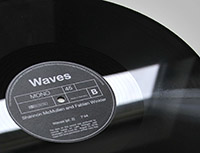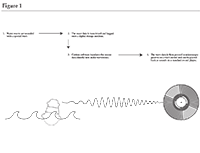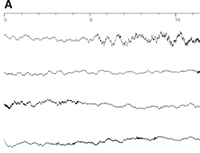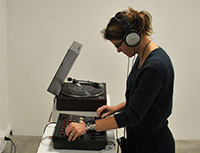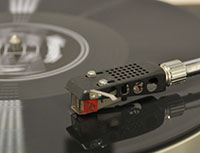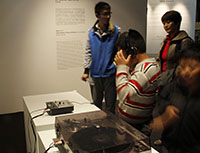Waves Records is a project about ecological, social and aesthetic
reflection on large bodies of water - the first one in this series being
Lake Michigan, close to our residence in Central Indiana. With the
scientific support of Dr. Cary Troy, an expert in fluid dynamics at Purdue
University, we were able to measure two different types of waves: surface
waves and internal waves measured below the lakes' surface by temperature
changes in the water. The waveforms of the recorded water waves were then
pressed in microscopic format as grooves on a vinyl record that can be
played back as sounds. Already in the 17th century, explorers and early
missionaries in the Great Lakes region felt this unique connection between
a natural environment and sound. In 1676 Father Louis André wrote about
the waters of Lake Michigan as "a vast Aeolian harp, wind driven into
vibration over a wide range of frequencies and resonances."1)
While some of the wave data is gathered from surface waves, influenced by
wind and other meteorological conditions, most of the sounds are from sensor
recordings of waves in a depth of 35m. They are less influenced by the current
weather above and represent fluctuations in the lakes' thermocline as an
indicator of long-term changes in the environment's climate. We translated
the data as directly as possible avoiding as much subjective interpretation
of the wave data as we could. A custom script in MatLab turned data points
into individual samples of an audio waveform. The vinyl record thus becomes
both a playback medium for the sonified water waves and a storage medium
for the sensor data. Tapping into the visual properties of the recorded
data sets as grooves on the record, the installation of this project
features large format prints of the sensor data. The presentation of
Waves Records is further accompanied by a documentation video
that captures the production process of the record and the project's socio-ecological
context.
By translating the phenomenological qualities of a changing natural environment
into sounds our goal is to create a discursive object in form of the vinyl
record bringing together scientific research, environmental awareness and
artistic experimentation.
1) Mortimer, Clifford H. "Lake Michigan in Motion." Madison:
University of Wisconsin Press, 2004.
